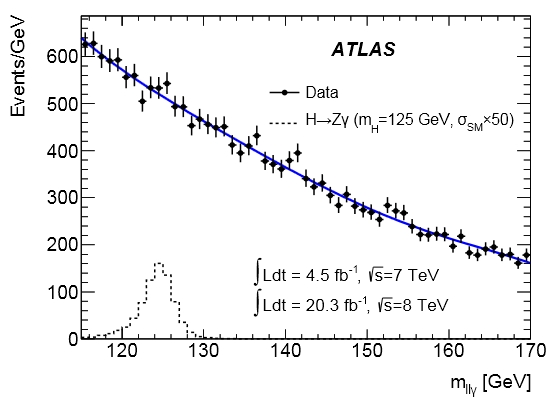The final state is in principle easy to trigger, identify, and reconstruct - the Z boson is well measured in its decay to electron-positron or muon pairs, and the energetic photon is tagged by an electromagnetic deposit in the calorimeter to which no charged track is pointing. However, the smallness of the signal makes the search a rather difficult one: besides the small cross section for producing Higgs bosons, we are here looking at a decay mode which in the standard model arises only once every 600 times. Then the Z decay to electrons or muons also plays a role in making the signal smaller, as ee and μμ pairs arise in their decay only about 7% of the time. Overall, we are talking of detecting the Higgs in a final state which arises on average just once every ten thousand decays !
As far as backgrounds are concerned, they are not large in an absolute sense -Zγ pairs are as I said a clean signature in proton-proton collisions- but the large dataset makes them quite large if compared with the tiny signal. They are due to standard model production of Zγ pairs not mediated by Higgs decay, as well as by spurious photon signals due to hadronic jets. The backgrounds have however a smooth exponential shape in the two-body mass distribution. This is basically the only handle to separate the signal.
The Zγ signal has been already searched by the competing CMS experiment, which last summer published a limit at 9.5 times the SM expectation. ATLAS does slightly worse than CMS, as they obtain an exclusion at 11 times the SM expectation. Hence the ATLAS paper does not "break ground"; however it is still interesting to look at the details of their search. The money plot is the invariant mass distribution that they obtain for Zγ pairs, which compares the data with the expected signal multiplied by a factor of 50 to make it more visible. It is shown in the graph below.
 In the graph the black points are ATLAS data, the blue line is a data-driven background model, and the hatched histogram on the lower left is the shape of the signal, multiplied by 50 times.
In the graph the black points are ATLAS data, the blue line is a data-driven background model, and the hatched histogram on the lower left is the shape of the signal, multiplied by 50 times.As you see, backgrounds are really high, and a signal will be impossible to see until we collect much more data in the next run. That is, unless the branching ratio to Zγ pairs is different from what the standard model predicts: new physics models in fact may suggest enhancements and surprises. From the experimental standpoint, the single most important ingredient in the search is the accurate reconstruction of the invariant mass of the Z and photon; while for the Z boson there is not a large margin of improvement, the precise determination of the energy of the latter is crucial.





Comments